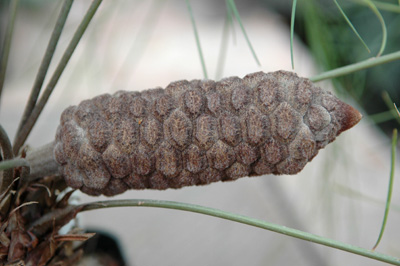We've come a long way since then. Floral development in particular has fascinated generations of botanists. Flowers comprise four parts, or 'whorls'–the sepals, petals, stamens, and carpel–listed from the outermost inwards. The sepals and petals, collectively called the perianth, are not always differentiated, and when they cannot they are called tepals. Non-flowering seed plants, or gymnosperms, such as pines, Ginkgo, and cycads, however, lack homologues to the perianth. Stamens and carpels, on the other hand, can be homologized to the male and female sexual organs of the gymnosperm cones (strobili). So where does the perianth come from?
One way to answer this question is to look at the genes involved in the development of the flower. We would expect that different genes are expressed in different whorls during development. The prevailing model used to explain this is the ABC (later the ABCE) model (Wikipedia): genes involved in floral development are expressed in a concentric, overlapping pattern, and the particular combination of gene expression in a tissue determines which whorl it becomes. For example, expression of class A genes alone produces sepals, class A+B produces petals, B+C give stamens, and C+E give the carpel. This model is based on work done on a handful of well-studied model plant species, especially Arabidopsis.
 |
| Diagram illustrating ABC model of floral development. Source: Wikimedia Commons. |
A research team led by Pamela and Douglas Soltis (husband and wife) has used a comparative approach to try and answer some of these questions. Instead of just focusing on the gene expression pattern (transcriptome) of only one model species, they looked at the floral transcriptome of four different angiosperms, representing different 'grades' of plant evolution, from the relatively basal water lily and a magnoliid (the avocado), to relatively advanced California poppy and Arabidopsis. They also compared this to cone development in a gymnosperm, the cycad Zamia.
   |
| L to R: Flowers of avocado (a magnoliid, representing basal angiosperms), Arabidopsis, and female cone of Zamia (different species from that used in the featured study). |
What about the perianth? Water lily and avocado do not have clearly differentiated petals and sepals (and so have 'tepals'). When compared with the cycad Zamia, the genes expressed in the perianth of angiosperms have more in common with genes expressed in the in male cones of Zamia, than those expressed in the female cones. This supports earlier hypotheses that perianths (tepals, sepals, and petals) are evolutionarily derived from male parts of gymnosperm cones, at least as far as their developmental programs are concerned.
There are some caveats, of course. Having only four angiosperm species and one gymnosperm, it's always a bit of a stretch to say that they are truly representative of 'basal' and 'advanced' angiosperms. Furthermore, some systematists might object to the idea of thinking in evolutionary 'grades' to begin with. That is to say, just because a certain species is basal–i.e. it diverged early in angiosperm evolution–doesn't mean it represents an ancestral, primitive state; after all, it's experienced millions of years of subsequent independent evolution, too. We should at least be cautious not to equate the basal condition with the ancestral condition. This is best understood by analogy to a family genealogy. If you meet distant cousins who are descended from a branch of the family that split off three generations ago, you would not assume that they resemble your great-grandparents in every detail. Sure, they would give you some information about what your great-grandparents were like, but you shouldn't assume straight away that they are identical.
Despite all that, it's still good to see comparative studies being done on plant development. Framing developmental questions in an evolutionary context, or Evo-Devo, is a big field now and is so appealing as a research theme, I think, because it puts the science in a narrative context, and telling stories is what we humans intuitively are drawn to, right?
4 comments:
There are 2 resources regarding the theory that a "plant is a leaf" besides Goethe that you cited:
One is on Popular Science way back 1874 (scroll down to page 141): Have Plants a Pedigree? and most recent from Prof. Isidro T. Savillo's web page:
4/06/2011~~It's a pondering interest to say that a plant is a leaf (In one flower species , a shoot sprout out from the whorl of petals*) equates with the statement that the leaf is a plant.
*The "leafy"gene which code for the modified leaves has been switched to the production of a shoot instead. Another rationale here is that the 4 basic floral organs minus the receptacle are modified leaves: sepals, petals, pistil and stamen. When it comes to reproduction, these two modified leaves will produce the seeds and the seeds will eventually become seedlings and later grow as plant. Be writing an article on the "Molecular Wonders of a Leaf" [Plant is a Leaf: Leaf is a Plant][Reserved]
Do you have Goethe's version? May you kindly paste it in your reply? Thanks.
Thanks for the links, especially the Popular Science one! Goethe described his theory in a short book that in English is called the Metamorphosis of Plants (Versuch die Metamorphose der Pflanzen zu erklären). A digitized copy of the German original is available from the Internet Archive. Please link to your article when it's done, I'm looking forward to reading it!
Brandon, It is Prof. I. Savillo who will be writing the article not me. That is part of his statement. Thanks for the information about Goethe's theory. I'll look for the english version.
What is the difference between Goethe's statement (1790)- "Every Part of the Plant is a Leaf" from the statements of Gunning (1874) and Savillo (2011) that a "Plant is a Leaf" ? Will they deviate in the conclusion or it will just be one?
Post a Comment